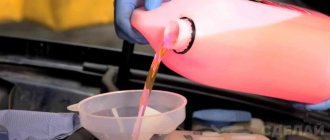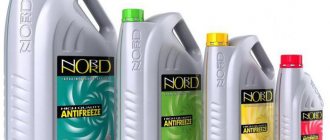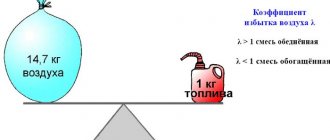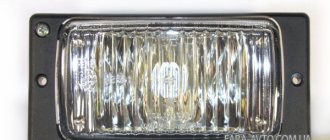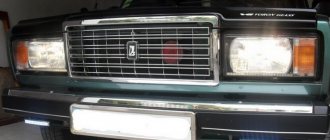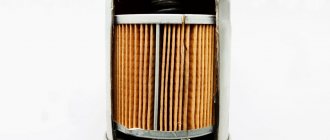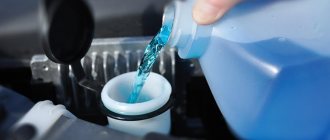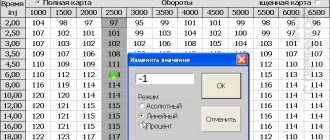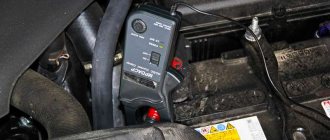Choice anti-freeze for cars in the winter season should be based on its minimum freezing temperature, composition, effectiveness, quality and price. The best winter windshield washer fluids are made based on isopropyl alcohol (isopropanol), and they have a sharp, specific odor that often scares off car owners. Conversely, counterfeit products that are odorless are often based on methanol, which is poisonous to the human body. In addition, the effectiveness of counterfeit anti-freezes is much lower than that of official ones.
Types of anti-freeze products on the Russian market.
Today we’ll talk about the types of anti-freeze (this is winter windshield washer fluid for car windows, if anyone doesn’t understand :)) and the difference between them, about the composition of anti-freeze, let’s see what and how much you should pour into your car. For quite some time now, the state has seriously taken up regulating the market of antifreeze liquid for cars. The main milestone of this activity was the ban on the production of methanol-containing antifreeze, which, on the one hand, inflated prices for the product, and on the other, paradoxically created a rush demand for methanol before the start of the season. Let’s immediately agree that we will not consider all kinds of home-made slurries from moonshine and other improvised alcohols, since fundamentally they are no different from the three mentioned below, except that sometimes they have such a smell that, as they say, it doesn’t stink so much as it hurts the eyes. So, today there are 3 main types of anti-freeze on the Russian market, differing in their main component - alcohol:
- isopropyl
- ethanol
- methanol
As you can see, alcohols are involved in the production - isopropyl, ethanol (painfully familiar to all of us :)), and methanol (a very dangerous poison). At the same time, the most expensive is ethanol, in the middle price segment is isopropyl and, finally, the cheapest is methanol slurry. Let's figure out whether expensive anti-freeze is worth the money and whether cheap anti-freeze is as dangerous as it is painted to be?
Anti-freeze Gleid - a hit of all times :)
What to do if a fake gets into the tank?
Unfortunately, extremely unpleasant situations for motorists occur quite often. During the day the temperature outside was above zero, but at night the temperature dropped below zero. As a result, the untested liquid purchased on the market froze. In such a situation, the only way out is to put the car in a warm place and let the anti-freeze thaw. If the reservoir with washer fluid is located near the engine, then running the car for half an hour will be enough for the fluid to melt on its own. All that needs to be done after this is to drain the old composition and add a new, but better one.
Composition of a spherical anti-freeze agent in a vacuum.
What, in principle, should the composition of an anti-freeze agent be? In total, it includes three mandatory components, one optional and one forced :). The required ones are alcohol, water and surfactants (surfactants), the optional one is a dye, and the forced one is an aromatic fragrance. It is forced because the mixture does not always have a pleasant or at least neutral smell, so you have to add a fragrance to, so to speak, improve the consumer properties (otherwise people simply won’t buy the smelly liquid). Below we will mainly talk about alcohol, since everything else can be identical and does not particularly affect the price of the final product. Surfactants and fragrances, of course, can also be different, but this is at the discretion of the manufacturer.
Surfactants work frankly poorly in winter (have you noticed the difference in the quality of washing in summer and winter?), so there is no point in spending money on some serious compositions; in the negative, none of them will wash adequately anyway.
Serious problems with fragrance (or rather, with its successful selection) arise only with isopropyl liquids, since isopropanol itself has a rather disgusting and poorly muffled odor. There is no such problem with other types of anti-freeze, so they add fragrances according to the “if only there is” principle. And, of course, there is the “premium” segment, where would we be without it. For dudes, there is a super-expensive and (most likely) quite high-quality NL, where the most carefully selected components will be fragrance and dye (plus the shape of the bottle and label).
Methanol preparations
In terms of technical characteristics, methyl alcohol is slightly inferior to ethyl alcohol.
Due to the moral decline in society, the production of these products in Russia has ceased, but illegal products can be found on store shelves at affordable prices. Experts believe that such windshield washer fluid is completely harmless if used as intended.
The main component is alcohol.
Now about alcohol. Its main and only task is to prevent water from freezing, so that even at minus 10/20/30 it continues to remain in liquid form and can flow through the hoses and spray out of the nozzles without freezing them. Yes, you also need to keep the reservoir tank intact, which will easily crack if it is filled with ordinary water without additives. A lyrical digression about the low-temperature properties of anti-freeze: It would seem that the lower the temperature that NJ can withstand, the better. Yeah, but this is not the optimal approach. For us, 2 properties of NV during frost are important, namely, washing the windshield (and rear windshield for some) from dirt and keeping the sprayer system intact (tank+hoses+nozzles..., you get the idea). The freezing point of an anti-freeze liquid is determined by the percentage of alcohol in it, which is the pricing component for the anti-freeze liquid. So, the problem of system integrity is solved by any ratio of the alcohol/water mixture, even down to minus 5C. Of course, at minus 7, everything will freeze completely, but at the same time, water mixed with alcohol loses its ability to expand when freezing, plus it freezes not as a large crystal (a piece of ice), but as a small pulp, without breaking anything. Now about the second task: this may not seem obvious, but it has been noticed that in frosts below minus 10-15C, dirt disappears from the roads and they become dry, since all the moisture from the air (and from the environment in general) has already taken the form of snow/ there is nothing for ice and dirt to form in. At low temperatures, the probability that it will snow is very low, so the “real” freezing degree below minus 15-20 degrees simply does not make practical sense. In such frost, you simply will not use the anti-freeze, since the glass will be clean (well, if, of course, you washed it after the last thaw :)). Nevertheless, traditionally, the vast majority of manufacturers, until recently, persistently wrote proudly “up to minus 30” on the labels of their products. And now they write, although the contents of nine out of ten jars will freeze much higher than the indicated temperature. But now honest -25, -20, and even -15C have appeared on the labels. There is no need to suspect such manufacturers of being too honest, it’s just that, as a rule, they are anti-freeze products made from expensive raw materials (ethanol, isopropanol), i.e., legally produced products. Accordingly, they inevitably have to comply, if not with GOSTs (which seem to be non-existent for antifreeze), then with the declared specifications and at the same time have a competitive price. So you have to write almost the true freezing temperature, so as not to get caught in deception, and to make the price as close as possible to the price of methanol. Life is much easier for methanol producers in some ways. They are already illegal, so they can freely write any texts on their labels, since in the case of a “false” they will be charged with much more serious offenses than the discrepancy between the declared freezing temperature and the real one. At the same time, methanol-containing products are the most popular on the Russian market due to their low cost. Prices differ by at least one and a half to two times, and car enthusiasts vote with rubles, not giving a damn, according to the old Russian tradition, about our harsh laws. It just so happens that the production of methanol costs significantly less than the production of isopropanol and ethanol, plus there is no need to bother with excise taxes (as with ethanol) or with fragrances (as with isopropanol). On the other side of the scale is the fact that methanol is a poison. Let's figure out how and how it and other alcohols can harm a person.
Non-freezing liquid: types, differences, selection criteria
It seems that not much is required from an anti-freeze device: it is good and quick to clean car windows in low temperatures. However, manufacturers achieve this with different liquid formulations, which, depending on the composition, acquire additional properties. Therefore, the answer to the question “which antifreeze liquid is best to use” depends on a number of criteria.
- Price and composition. Ethyl alcohol resists freezing best, but it is expensive, including due to excise taxes and taxes imposed on such products. In addition, when using it, the interior is filled with the smell of alcohol. A cheap alternative of good quality is methyl alcohol, which has virtually no odor. Unfortunately, this substance is extremely toxic: the lethal dose is 30 g, so its circulation is prohibited. It is being replaced by isopropyl alcohol - also a poison, but with a strong odor that has to be masked with fragrances. In addition, isopropyl alcohol has a viscosity 6 times higher than methanol: in severe frosts, the composition may not reach the glass at all.
- Real freezing temperature. Since the proportion of alcohol in winter liquid reaches 70%, even well-known brands are tempted to save money. But the more water, the higher the thickening temperature of the liquid in the tank. The -20°C stated on the label can turn into either -16 or -24: it all depends on the manufacturer’s conscience and the reliability of quality control.
- Harmless to cars. The aggressive cocktail not only dissolves dirt, but also corrodes paint, rubber, metal, and even polycarbonate optics. We have already published a rating of budget cars for 2022: rising prices for cars and spare parts recommends treating them with care.
So the question is worth rephrasing: how to choose a good anti-freeze agent that is odorless, has a low thickening point and is safe for humans and cars? Do such liquids even exist in nature? Fortunately, it still is. We compiled their rating.
Human exposure to various antifreeze components.
Methanol is the hero of ominous warning posters from the post-war USSR, the culprit of many cases of death or blindness of workers. As far as I remember, the dose sufficient to cause blindness is only 15 ml, for death in 50% of cases it is about 30 ml. I could be wrong in the numbers, but the order is exactly this: one glass inside, and the poor fellow suddenly finishes all his business in this world. However, it must be taken into account that the vast majority of motorists buy anti-freeze liquid for washing windows, and not for internal use, and besides, on all NJs without exception, they always write about the inadmissibility of such use of the product, regardless of what it is made of. So the question arises, is methanol harmful if you don’t drink it? European legislators, by the way, fully allow the use of methanol-based anti-freeze, so, apparently, in their opinion, there is either no harm or it is “negligible” (implying that a person will die sooner from the consequences of eating hamburgers, chicken wings, potatoes- fries and cola :)). If you delve into the jungle of metabolic transformations, you will find out that after the next conversion of methanol in the body, formaldehyde is formed, which is a poison of the first class of danger (the most dangerous, in general). On the one hand, there is already plenty of it around (exhaust gases, smoking, emissions from factories, incomplete combustion of hydrocarbons in general...). On the other hand, now you know that every time after pressing the sprayer lever you smell the aroma of lemon/breeze/apple/bubble gum..., along with this smell you inevitably inhale a particle of methanol, which inside you will turn into formaldehyde, adding problems to your body. At one time, this became a factor for me that forced me to switch to isopropyl antifreeze, since I had to carry small children around a lot, and unlike mine, I didn’t give a damn about their health :). So, what does isopropyl alcohol, which we so often inhale when washing our windshield, turn into? And it turns into banal acetone. It seems that this is also nothing good, but the fundamental difference is that in small quantities acetone is even produced by our body during normal metabolism, which means that we have “standard” ones, verified by millions of years of evolution (or by divine genius, who really believes in what). :)) methods of neutralization and disposal of this compound, which implies no harm to the body in microdoses (inhalation of NG vapors). I think there is no point in writing about ethanol; everyone already has an extremely clear picture of the impact of ethanol on humans, and many take a systematic part in this picture :). It is worth emphasizing that denatured alcohol is used to produce anti-freeze, which is formally unsuitable for consumption as an alcoholic beverage.
Premium segment windshield wipers
Top 5 best summer washers for premium cars:
- Summer screenwash conc. The best glass cleaning liquid is produced in Japan by Honda and is delivered to our country only upon order. 250 ml of the product will cost the driver approximately 15 thousand rubles.
- SSWA-CC-2050-9A. The Mazda washer removes traces of dust, pollen, oils and insect residues from the first pass. 50 ml cost 5.5 thousand rubles.
- A 17. The concentrate created by the Mercedes concern easily copes with even stubborn stains and stains. The price of 40 ml of liquid is 1 thousand rubles.
- Optikleen 1051515. A windshield wiper for summer produced by General Motors quickly removes any stains, dust and greasy stains from the glass. A liter can be purchased for 900 rubles.
- Glass Cleaner Crystal liquid from LAVR is suitable not only for glass, but also for washing the car body and interior. The composition easily removes dirt and does not damage rubber, plastic or chrome surfaces. The cost of a liter of product is about 800 rubles.
Summer screenwash conc
Expensive washer fluids differ from budget ones in the speed and quality of cleaning, as well as a pleasant smell and convenient packaging.
How to find out what the antifreeze is made of.
So what is anti-freeze made of? The first method, “frontal”, is to read the composition on the label. Not a panacea, since you won’t find any mention of methanol on any label; at least isopropyl alcohol will be everywhere. You can probably trust the label if it says denatured ethyl alcohol. The substance is expensive, there is no point in lying like that. Method two, by smell. As I said above, isopropanol has a very specific unpleasant odor, which is poorly masked by fragrances, so if the anti-freeze product “stinks,” then most likely it is made from isopropyl alcohol. Methanol NL does not smell of anything (except for fragrance, of course), just like ethanol, so this method will not work with them. Although if you combine this method with the first, then using the deductive method of A. Conan Doyle :) you can understand that a bottle with a label that mentions isopropanol and does not have any unusually unpleasant odors most likely contains methanol. The third sign will help us finally be convinced of this - price. It is precisely this advantage that outweighs all the shortcomings of both production and consumption. So if we add to our suspicions a price tag of around 100-120 rubles for 5 liters, then the picture can be considered clear. True, there remains the option that they can try to sell methanol at a high price, but this is unlikely, since wholesalers always know what they are reselling the product from and at what freezing temperature. Here I would like to draw attention to another non-obvious observation. When driving at medium intensity in an “average” (so to speak) winter, it is unlikely that more than 20 liters of anti-freeze will be used per season (I used to get by with two, and one and a half liters...). These are 4 bottles of methanol for 120 rubles, or 4 bottles of isopropanol for 200 rubles, roughly speaking. The difference is only 320 rubles for about 5-6 months - in my opinion, this is a strong argument in favor of the “official” antifreeze liquid.
Which windshield washer fluid is best to buy?
How to choose, what to look for when buying, what mistakes to avoid when choosing? Some vehicle owners select antifreeze solely by its smell. Most experts recommend that before purchasing such a product, you first familiarize yourself with its composition:
- Some manufacturers produce antifreeze products using methanol (it is a toxic substance that does not have a pronounced odor, but can irritate the surface of the skin, as well as the mucous membrane of the respiratory tract);
- Isopropyl alcohol is often used (it has a pronounced, pungent odor that is somewhat reminiscent of acetone);
- Sometimes the composition contains ethanol (it does not have a pungent odor and is capable of providing high anti-freezing properties of the composition, but increases its cost).
To hide a pungent odor, for example, if isopropyl alcohol is present in the composition, manufacturers use special flavors and fragrances. In addition, when choosing a washer, it is recommended to pay attention to the packaging in which it is sold.
Compositions produced in ordinary plastic bottles, as a rule, cost much less than analogues sold in presentable canisters. However, drugs sold in cheap containers most often contain methanol and are toxic substances.
Reference! The manufacturer indicates on the packaging the recommended ambient temperature that is suitable for using the composition. Summer washers freeze with the onset of cold weather and can damage the tank. Therefore, with the arrival of winter, they need to be drained and replaced with washers designed for use in low temperature conditions.
Bottom line.
Traditional summary of the article: There are 3 main types of antifreeze liquids, differing in the main component - alcohol, methanol, ethanol and isopropyl. Any antifreeze consists of at least water, alcohol and surfactants with the addition of flavors and dyes. The price-forming component is alcohol; methanol, although prohibited, is the cheapest, therefore it is used everywhere in production. The information on the price tag about the freezing temperature of “minus 30” is not true in most cases, and has no practical meaning. At temperatures below -15, glass, as a rule, does not become dirty. Methanol antifreeze, although illegal, is the most widespread and commercially available due to its low cost. There is harm from methanol, but it’s akin to cigarettes, you definitely won’t die from one :). The main thing is not to drink it under any circumstances! In the absence of reliable information, you can determine what an anti-freeze product is made of using a combination of three factors: label, price tag and smell. The cheap one is 100% methanol, it smells unpleasant (with a characteristic odor) and is much more expensive - isopropanol, with a proud inscription on the label at an exorbitant price - most likely ethanol. For this, I believe that I have given enough information for an informed choice of the antifreeze used with full awareness of the advantages, disadvantages and consequences of using the chosen liquid. That's all.
PS: If anyone is interested, here is a link to an article about the composition of motor oil, you never know :)
No similar publications
The best anti-freeze devices 2021-2022 according to consumer reviews
Liqui Moly Antifrost Scheiben-Frostschutz
Widespread, high quality product. The line of anti-freeze products is represented by ready-made products with temperatures of -12, -15, -20, -270C and a concentrate with a freezing point of -700C. This choice allows you to choose a product in appropriate weather conditions.

